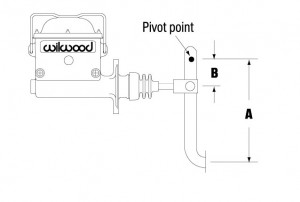Q: I’m putting together a disc brake system for a custom build. What can you tell me about setting up brake pedal ratio for optimum performance? Also, what can you tell me about master cylinders? Specifically, what do I need to know about the bore size of the master cylinder?
A: On average, brake pedal ratio should range from 5.1:1 to 7.1:1. To calculate your ratio, measure the distance from the pivot point of the pedal to the center of the pedal pad (measurement A), and then the  distance between the pivot point and the master cylinder pushrod hole (measurement B). Next, divide measurement A by measurement B. If A=14 inches and B=2.3 inches, your ratio is 6.08:1 (14/2.3=6.08). Increasing the pedal ratio increases leverage and pedal travel. Conversely, decreasing the ratio yields less leverage and pedal travel along with increased pedal effort. Make sure the master cylinder pushrod angle does not exceed 5 degrees while setting up your pedal ratio.
distance between the pivot point and the master cylinder pushrod hole (measurement B). Next, divide measurement A by measurement B. If A=14 inches and B=2.3 inches, your ratio is 6.08:1 (14/2.3=6.08). Increasing the pedal ratio increases leverage and pedal travel. Conversely, decreasing the ratio yields less leverage and pedal travel along with increased pedal effort. Make sure the master cylinder pushrod angle does not exceed 5 degrees while setting up your pedal ratio.
A properly engineered brake system should deliver sufficient fluid volume to produce a firm, responsive pedal while generating enough pressure to stop your vehicle comfortably. A typical disc brake system requires between 900 and 1,200 psi at the brake caliper (as measured with a pressure gauge). Most master cylinders have a bore size of 5/8-inch to 1 1/8-inch. Larger-bore master cylinders move a high volume of brake fluid, at lower pressure with less pedal travel. A smaller bore moves less fluid at higher pressure with increased pedal travel. If fluid pressure at the caliper measures low, reducing the master cylinder’s bore size will increase pressure and vice-versa.
…

Could we get an article on finding the right tire pressure for custom cars? Obivously adding or removing weight will effect optimum pressure. But does changing tire size?
[…] may help: Monday Mailbag: How to Calculate Brake Pedal Ratio and Master Cylinder Size – OnAllCylinders 8 to 1 is an aggressive ratio, "should" be more in the 5-7 to 1 ratio. You may have a […]
[…] Learn how to calculate the brake pedal ratio […]
What happens if the pedal ratio is way above 7:1 ratio for eg 10:1, what happens in this case…..
The higher pedal ratio will require more pedal travel to complete the proper stroke of the master cylinder (vs. a lower ratio like 6.1:1). It will also make it easier to push the pedal and stop the vehicle because the higher ratio will give you more leverage.
The downside of having too high of a pedal ratio is braking can get to a point where its too much travel and leverage for the system to operate with the correct “feel” and function, in your case it could lead to being too sensitive.
On a manual brake system sometimes a higher ratio can be beneficial, as long as pedal travel isn’t excessive, or the pedal travels all the way to the floor (or close too it) before the vehicle comes to a stop, you need to leave room for brake wear and a margin of error in the brake system.
There is a balance to find, and 5.1 to 7.1:1 is the industry standard, and yes there are exceptions to this.
Another thing to consider is how the master cylinder bore size will play a role in this, The larger the bore the less leverage (and travel) you have and vice-versa. Larger bores move more fluid with the same amount of travel than smaller bores do.
If you have a brake pedal with a low amount of travel that’s very firm, I would suggest reducing the bore size, this applies in the other direction as well, a pedal that travels too far and too sensitive should increase bore size.
Hope this helps.
[…] with pedal ratios are more common in older muscle cars than in more modern designs, but it does still crop up […]